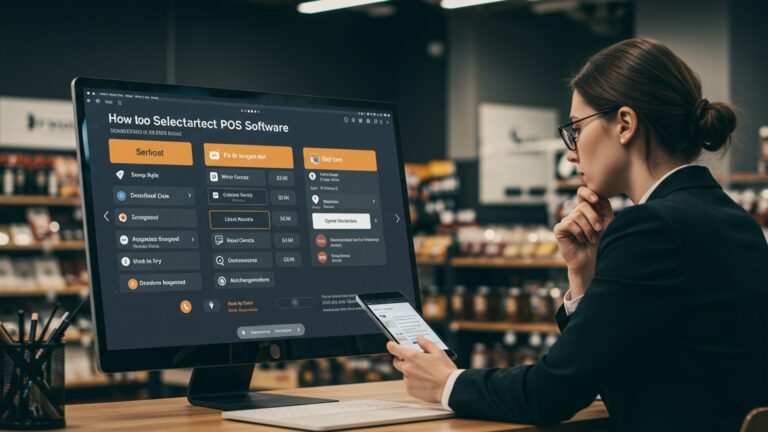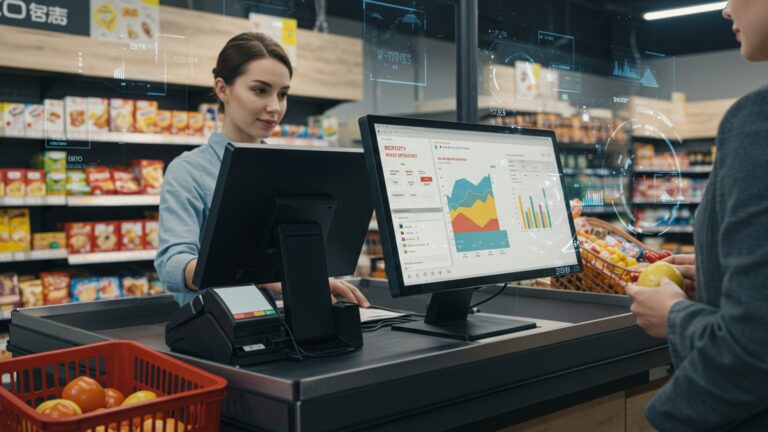Learn How Mobile POS Software Boosts Sales and Customer Experience
The modern retail environment demands agility and personalized service, a challenge traditional fixed point-of-sale systems often fail to meet, creating friction points for both staff and customers. Embracing mobile POS software transforms these limitations into opportunities, empowering businesses to process transactions, manage inventory. access customer data directly from the sales floor or even off-site events. This technological shift, exemplified by the rapid adoption of tap-to-pay solutions and real-time inventory synchronization, not only streamlines operations but also significantly enhances the customer experience by reducing wait times and enabling more informed, personalized interactions, directly translating into increased sales and stronger brand loyalty.

Understanding Mobile POS Software: The Modern Retail Edge
In today’s fast-paced retail and service environments, the traditional stationary cash register is quickly becoming a relic of the past. Enter mobile POS software – a transformative technology that allows businesses to process transactions, manage inventory. interact with customers using portable devices like smartphones and tablets. At its core, mobile POS software is a sophisticated application that turns a standard mobile device into a fully functional point-of-sale system, untethering businesses from the counter and offering unprecedented flexibility.
Unlike conventional fixed POS systems that require dedicated hardware and are confined to a specific location, mobile POS solutions leverage the power of cloud computing and wireless connectivity. This means sales associates can assist customers, look up product insights. complete purchases from anywhere within the store, at a pop-up event, or even at a customer’s location. The primary components typically include:
- Mobile Device
- Card Reader
- Receipt Printer (Optional)
- Cloud-Based Backend
A smartphone or tablet running the mobile POS software application.
A small device that attaches to the mobile device, enabling magnetic stripe, EMV chip, or NFC (contactless) payments.
Portable Bluetooth printers for physical receipts, though many solutions offer digital receipts via email or SMS.
Where all sales data, inventory, customer insights. reports are stored and managed securely.
This agility is not just about convenience; it’s a strategic advantage that significantly impacts both a business’s sales potential and its ability to deliver an exceptional customer experience.
Driving Sales Growth with Mobile POS Software
The immediate impact of implementing mobile POS software on sales figures can be profound. By removing the physical constraints of a fixed checkout, businesses can unlock new revenue streams and optimize existing ones.
- Increased Transaction Speed and Reduced Abandonment
- Enhanced Upselling and Cross-selling Opportunities
- Expanded Sales Channels
- Optimized Inventory Management
- Data-Driven Decision Making
Long queues are a major deterrent for customers. Mobile POS allows staff to “line bust” by processing transactions on the spot, significantly reducing wait times. For instance, a coffee shop during peak hours can have baristas take orders and payments directly at the counter or even while customers are waiting in line, preventing potential customers from walking away due to perceived delays.
With a mobile device in hand, sales associates have instant access to product catalogs, customer purchase histories. inventory levels. They can recommend complementary products or higher-value alternatives based on real-time data, turning a simple purchase into a more substantial sale. Imagine a clothing store associate suggesting a matching accessory for an item a customer is holding, completing the sale right there on the floor.
Mobile POS software empowers businesses to sell beyond their brick-and-mortar storefronts. Pop-up shops, farmers’ markets, trade shows. even home service calls become viable sales points, reaching new customer segments without the overhead of a permanent setup. A local artisan selling crafts at a weekend market can process credit card payments as easily as a large retailer, significantly boosting their potential revenue.
Real-time inventory tracking is a cornerstone feature of robust mobile POS software. This prevents stockouts of popular items and overstocking of slow-moving ones. By having accurate, immediate data, businesses can make informed purchasing decisions, ensuring they always have what customers want, when they want it, thus never missing a sale due to unavailable stock.
The backend analytics provided by mobile POS software offer invaluable insights into sales trends, peak hours, best-selling products. employee performance. Businesses can leverage this data to optimize staffing, tailor marketing campaigns. refine product offerings, all contributing to increased sales efficiency and profitability.
Elevating Customer Experience through Mobile POS
Beyond boosting sales, mobile POS software plays a critical role in transforming the customer experience, making interactions more personal, convenient. satisfying. In an age where customer loyalty is hard-won, these improvements are invaluable.
- Personalized Interactions
- Reduced Friction and Seamless Checkout
- Flexible Payment Options
- Digital Receipts and Eco-Friendliness
- Improved Accuracy and Returns
Sales associates can access customer profiles, loyalty points. past purchase history directly from their mobile device. This allows for highly personalized service, greeting customers by name, understanding their preferences. offering tailored recommendations. For example, a salon can quickly look up a client’s last service and product preferences, ensuring a consistent and personalized experience.
The ability to complete transactions anywhere in the store eliminates the dreaded “checkout line.” Customers appreciate the convenience of not having to wait, leading to a more positive shopping experience. This is particularly beneficial in busy retail environments like clothing stores or electronics shops, where staff can finalize sales directly on the floor.
Modern mobile POS software supports a wide array of payment methods, including credit/debit cards (EMV chip, magstripe), NFC contactless payments (Apple Pay, Google Pay). even digital wallets. Offering customers their preferred payment method enhances convenience and satisfaction.
The option to email or SMS receipts not only reduces paper waste but also provides customers with a convenient digital record of their purchase, which is easily accessible and less likely to be lost.
By integrating sales data directly, mobile POS software minimizes manual errors in pricing or product entry. Moreover, processing returns and exchanges becomes much smoother, as staff can quickly look up past transactions, enhancing efficiency and customer trust. A customer returning an item doesn’t need to hunt for a paper receipt if their purchase history is digitally accessible.
Essential Features of Robust Mobile POS Software
When evaluating mobile POS software, certain features stand out as critical for maximizing its potential to boost sales and customer experience. A comprehensive solution should offer more than just transaction processing.
- Comprehensive Payment Processing
- Real-time Inventory Management
- Customer Relationship Management (CRM)
- Detailed Sales Reporting and Analytics
- Employee Management
- Offline Mode Capability
- Integrations with Other Business Tools
- Security Features
Must support all major payment types, including EMV chip cards, magnetic stripe, NFC contactless payments (Apple Pay, Google Pay). potentially even alternative payment methods like QR code payments.
This is non-negotiable. Features should include real-time stock updates across multiple locations, barcode scanning capabilities, stock alerts. supplier management.
Ability to create and manage customer profiles, track purchase history, manage loyalty programs. segment customers for targeted marketing.
Customizable reports on sales trends, product performance, employee performance, peak hours. tax insights are crucial for informed business decisions. Dashboards with visual data representation are highly beneficial.
Features like time tracking, role-based permissions, sales performance tracking. commission calculations streamline operations and accountability.
Essential for maintaining operations during internet outages or in locations with unreliable connectivity. Transactions should be stored and synced once connectivity is restored.
Seamless integration with accounting software (e. g. , QuickBooks, Xero), e-commerce platforms (e. g. , Shopify, WooCommerce), marketing automation tools. CRM systems creates a unified business ecosystem.
PCI compliance, end-to-end encryption for transactions. robust data security protocols are paramount to protect both business and customer data.
Real-World Impact: Mobile POS in Action
The versatility of mobile POS software means it’s not just for large retailers; businesses of all sizes and across various industries are leveraging it to great effect. Here are a few examples showcasing its real-world application:
- Small Boutiques and Retail Stores
- Food Trucks and Cafes
- Service Businesses
- Pop-up Shops and Market Stalls
Sarah, who owns a trendy clothing boutique, adopted mobile POS software to empower her sales associates. Instead of customers waiting at a fixed counter, associates can now walk the floor, answer questions, check inventory on their tablet. complete sales right beside the customer. This personal touch has significantly reduced abandoned carts and increased average transaction value by allowing staff to easily suggest complementary items. Sarah noted a 15% increase in impulse buys within the first three months.
For businesses that thrive on mobility and speed, like food trucks or outdoor cafes, mobile POS is indispensable. Consider “The Daily Grind,” a popular coffee truck. Their baristas use ruggedized tablets with mobile POS software to take orders and payments quickly, even in busy festival environments. This not only keeps lines moving but also ensures accurate order taking and sales tracking, which was a challenge with cash-only systems.
Field service technicians, plumbers, or mobile beauty therapists can use mobile POS software to bill clients on-site, process payments immediately. even schedule follow-up appointments. This professionalism and efficiency enhance customer trust and improve cash flow. A mobile car detailing service, for example, can present a digital invoice and accept payment instantly after a service, eliminating the need for paper invoices or mailing bills.
Temporary retail setups benefit immensely from the portability of mobile POS. Whether it’s a seasonal gift shop or an artist selling wares at a craft fair, having a full-featured POS system that fits in a backpack enables them to operate professionally anywhere, accepting various payment types and managing inventory on the fly. This accessibility allows entrepreneurs to test new markets with minimal overhead.
These examples highlight how mobile POS software isn’t just a convenience; it’s a strategic tool that drives operational efficiency, customer satisfaction. ultimately, business growth.
Selecting the Ideal Mobile POS Solution for Your Business
Choosing the right mobile POS software is a critical decision that can significantly impact your business’s success. With numerous options available, a thoughtful approach is essential. Here are actionable steps to guide your selection process:
- Assess Your Specific Business Needs
- Industry
- Size and Scale
- Key Features
- Budget Considerations
- Software Costs
- Hardware Costs
- Transaction Fees
- Ease of Use and Training
- An intuitive interface reduces staff training time and minimizes errors. Look for systems with clean designs and logical workflows.
- Many providers offer free trials or demos. Take advantage of these to test the system with your team.
- Security and Compliance
- Ensure the mobile POS software is PCI compliant to protect customer credit card data.
- Look for features like end-to-end encryption and secure data storage.
- Integration Ecosystem
- Does the software integrate seamlessly with your existing accounting software (e. g. , QuickBooks, Xero), e-commerce platform, or CRM? A unified system prevents data silos and enhances efficiency.
- Customer Support
- Evaluate the quality and availability of customer support. 24/7 support, phone, email. live chat options can be crucial, especially for businesses operating outside standard hours.
- Read reviews about their support responsiveness and helpfulness.
Are you retail, restaurant, service-based, or mobile? Different industries have unique requirements (e. g. , table management for restaurants, appointment booking for salons).
How many employees, locations. monthly transactions do you anticipate? Ensure the system can grow with your business.
Beyond basic payment processing, what specific functionalities are non-negotiable for your operations (e. g. , advanced inventory, loyalty programs, multi-location support)?
Most mobile POS software operates on a subscription model (monthly or annually). Compare different tiers and what features they include.
Account for the cost of mobile devices (if not already owned), card readers, receipt printers. any other peripherals.
comprehend the processing fees associated with each payment. These can vary significantly between providers and payment types.
By carefully evaluating these factors, you can select a mobile POS software solution that not only meets your current needs but also positions your business for future growth and continued success in enhancing both sales and customer satisfaction.
Conclusion
Ultimately, embracing mobile POS isn’t merely about convenience; it’s a strategic imperative that directly translates into higher sales and a markedly improved customer journey. The real magic, in my experience, happens when staff are empowered to meet customers where they are, transforming potential bottlenecks into seamless transactions. Consider the dynamic energy of a pop-up shop or a bustling market stand; mobile POS allows for instant, secure payments, mirroring the efficiency of a fixed register but with unparalleled flexibility. This adaptability isn’t just a trend; it’s a fundamental shift in retail, enhanced by features like contactless payments and instant inventory checks. To harness this power, I urge you to proactively evaluate mobile POS solutions that align with your unique operational flow. Don’t just look for a device; seek a system that integrates deeply, offering real-time data insights that inform your next strategic move. By making this investment, you’re not just upgrading technology; you’re cultivating a more agile business, ensuring every customer interaction is swift, pleasant. profitable. For further insights into the transformative power of mobile POS, explore this resource on the broader impact of mobile technology in retail: Forbes Advisor: Best Mobile POS Systems.
More Articles
Guide to Implementing Mobile POS Software for Flexible Business Transactions
Learn How POS Software Can Revolutionize Your Small Business Operations
How to Choose the Best POS Software for Your Retail Store Success
How to Streamline Your Billing with Effective POS Billing Software Solutions
Guide to Using Android POS Software for Seamless Business Transactions
FAQs
What exactly is mobile POS software?
It’s a point-of-sale system that runs on mobile devices like tablets or smartphones. Instead of a bulky cash register, you can process transactions, manage inventory. more, all from a portable device, making your business operations much more flexible.
How can this kind of software help my sales numbers go up?
Mobile POS boosts sales in several ways. It speeds up transactions, reduces wait times (meaning fewer abandoned carts or lost sales), allows staff to upsell or cross-sell right on the sales floor. can even facilitate sales in unconventional locations like pop-up shops or outside the traditional checkout counter.
Does mobile POS actually make customers happier?
Absolutely! Faster service is a big win for customers. They don’t have to wait as long in line. Plus, staff can offer more personalized attention, look up product details instantly, check inventory on the spot. even process returns or exchanges more smoothly, all contributing to a better overall shopping experience.
What specific features should I look for to improve customer experience?
Look for features like quick payment processing (including contactless options), real-time inventory checks, customer relationship management (CRM) tools to track preferences, digital receipts. the ability to handle returns or exchanges efficiently. A user-friendly interface for your staff is also key for smooth interactions.
Is mobile POS hard to integrate with my existing business operations?
Many modern mobile POS solutions are designed to be user-friendly and offer relatively straightforward integration. They often connect seamlessly with other business tools like accounting software or e-commerce platforms. While there’s always a learning curve, the benefits usually outweigh the initial setup effort.
Can mobile POS help manage inventory more effectively?
Yes, definitely. Mobile POS systems often come with robust inventory management features. You can track stock levels in real-time, get alerts for low stock, manage multiple locations. even conduct inventory counts directly from a mobile device, reducing errors and improving accuracy across your business.
Is mobile POS only for big stores, or can small businesses benefit too?
Mobile POS is incredibly beneficial for businesses of all sizes, especially small ones. It offers a cost-effective alternative to traditional POS systems, provides flexibility for businesses with limited space or those that operate on the go (food trucks, market stalls). helps small businesses deliver a professional and efficient customer experience that rivals larger competitors.






